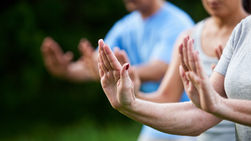If tension is created by un-movement, ease is created by movement
- Akiko Tsukamoto

- Mar 4, 2017
- 2 min read
My childhood teachers often told me that I should ease my tension when I'm playing the piano and that should try to relax when I get tense. There were teachers that mentioned that my sound was harsh when I was tense and I should use my ears to listen to 'soften' the sound. I completely understood what they were telling me, but the problem is that those words did not translate directly into un-tension for me. I did not physically grasp the idea on what it was to not be tense when I play, though I understood it mentally, and thus I struggled with un-tensing myself for a while.
It was when I started practicing Kendo, a Japanese samurai swords man martial arts, that I start understanding the notion tension and ease a little bit.
Wearing the heavy protective gear, the score is made when the tip of the bamboo sword hits the opponent in the head, gut, wrist, or neck. In order swing up the long sword with the very heavy protective gear on and swing it straightly at the opponent smoothly requires incremental adjustment of the whole body at every given split second during the motion. Even after the point of contact with the opponent, unless your whole body was continuously on the move, you were risking either being hit from un-movement, or miss the chance of making the score as a result of your slow movement from tension. I suspect as a Samurai, it was practically impossible to be on the battle ground without practicing your whole body awareness, or you would have been risking your own life.
And thus I started to understand that tension was caused by temporary immobilisation of a part or parts of body. As I started to reverse that thought, I knew I had to have 'movement' to be at the state of ease which translated into the following...
If tension is created by un-movement, ease is created by movement.
Sometimes our movements 'freeze' being under the spell of dystonia. Once we know that we have the option to initiate the movement, the spell starts breaking.
































Comments